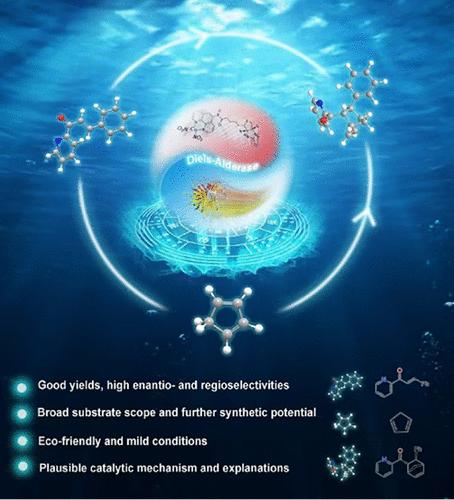Efficient Artificial Cu(II)-Diels–Alderase Based on Streptavidin for Highly Enantio- and Regioselective Diels–Alder Reactions
IF 13.1
1区 化学
Q1 CHEMISTRY, PHYSICAL
引用次数: 0
Abstract
The enzymatic Diels–Alder reaction presents an environmentally appealing strategy for synthesizing chiral norbornene scaffolds. In this study, an artificial Diels–Alderase was constructed by incorporating a biotinylated Cu-phenanthroline cofactor (5-NH2Phen-biotin*Cu(NO3)2) into streptavidin and optimizing the enzyme through genetic engineering. The S112D variant of this artificial Diels–Alderase exhibited commendable catalytic performance, facilitating highly enantio- and regioselective Diels–Alder reactions. Employing this method, we synthesized a series of norbornene pyridones with broad substrate scopes and good functional group tolerance under mild conditions, achieving high yields along with good enantio- and regioselectivities. Molecular dynamics (MD) simulations provided insights into the critical complex intermediates involved in the proposed reaction mechanism and clarified the interactions between the Diels–Alderase and its substrates, revealing the structural basis for the generation of the predominant norbornenepyridone conformation and the enhanced selectivity observed with the S112D mutant. Furthermore, quantum mechanics/molecular mechanics (QM/MM) calculations analyzed the reaction energy barriers of possible transition states, elucidating the reason for the formation of the target product from an energetic perspective.

基于链亲和素的高效人工Cu(II)- diels - alderase用于高对映性和区域选择性Diels-Alder反应
酶促Diels-Alder反应提出了一种具有环境吸引力的合成手性降冰片烯支架的策略。本研究将生物素化的Cu-phenanthroline辅因子(5- nh2pheni -biotin*Cu(NO3)2)加入链霉亲和素中,并通过基因工程对酶进行优化,构建了Diels-Alderase。该人工Diels-Alderase的S112D变体表现出良好的催化性能,促进了高度对映性和区域选择性的Diels-Alder反应。利用该方法,我们在温和条件下合成了一系列底物范围广、官能团耐受性好的降冰片烯吡啶酮,产率高,对映选择性和区域选择性好。分子动力学(MD)模拟揭示了参与该反应机制的关键复杂中间体,阐明了Diels-Alderase与其底物之间的相互作用,揭示了主要降骨片烯epyridone构象产生的结构基础,以及S112D突变体观察到的选择性增强。此外,量子力学/分子力学(QM/MM)计算分析了可能过渡态的反应能垒,从能量的角度阐明了目标产物形成的原因。
本文章由计算机程序翻译,如有差异,请以英文原文为准。
求助全文
约1分钟内获得全文
求助全文
来源期刊

ACS Catalysis
CHEMISTRY, PHYSICAL-
CiteScore
20.80
自引率
6.20%
发文量
1253
审稿时长
1.5 months
期刊介绍:
ACS Catalysis is an esteemed journal that publishes original research in the fields of heterogeneous catalysis, molecular catalysis, and biocatalysis. It offers broad coverage across diverse areas such as life sciences, organometallics and synthesis, photochemistry and electrochemistry, drug discovery and synthesis, materials science, environmental protection, polymer discovery and synthesis, and energy and fuels.
The scope of the journal is to showcase innovative work in various aspects of catalysis. This includes new reactions and novel synthetic approaches utilizing known catalysts, the discovery or modification of new catalysts, elucidation of catalytic mechanisms through cutting-edge investigations, practical enhancements of existing processes, as well as conceptual advances in the field. Contributions to ACS Catalysis can encompass both experimental and theoretical research focused on catalytic molecules, macromolecules, and materials that exhibit catalytic turnover.
 求助内容:
求助内容: 应助结果提醒方式:
应助结果提醒方式:


